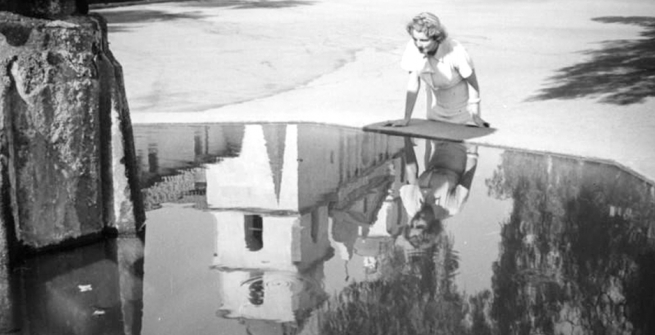We have written before about Herman Schultheis, the German-born photographer and jack of all film-related trades. With his wife, Ethel, Herman arrived in Los Angeles in 1937 with high hopes of a career in the film industry. He did find work with Disney, where for a few short years he had a hand in the special effects magic used to create Fantasia, Pinocchio, and other animated classics. Today he is best remembered for several secret notebooks he put together documenting the processes used to create that magic, as well as for his mysterious disappearance in a Guatemalan jungle in 1955. Following the death of Ethel in 1990, conservators found a trove of thousands of photographs in the Schultheis home in the Los Feliz neighborhood. Documenting a wide swath of life in the Southland, these snapshots were deeded to the Los Angeles Public Library. Nearly 6,000 have been digitized. A handful are presented here. All contemporary photos are by the author.
Sometime in 1938 Herman and Ethel made a trip to Santa Barbara, that charming town up the coast from Los Angeles along El Camino Real, now the 101 Freeway. It may have been a day trip, or perhaps the couple spent the weekend. The trip was, no doubt, a chance for the Schultheises to relax and indulge their favorite activities—exploration and photography. Without realizing it, they were also documenting the newly reinvented Santa Barbara, now fully committed to honoring, and capitalizing on, its Spanish colonial roots.

Our contemporary photo shows the original lavanderia still in place in front of the mission. The mission’s second bell tower is obscured by the tree. The bear’s head spout is a re-creation but may have been original at the time Schultheis took his photo. The mountain lion spout, pictured below, is an original Chumash carving.

Herman and Ethel visited the splendid Santa Barbara Courthouse. This working county courthouse was built in the late 1920s in Spanish Colonial Revival style. Following a devastating earthquake in 1925, the city elders decided to rebuild much of the town in this style, creating what to this day appears as a whitewashed, red-tiled Spanish theme park on the California coast.

The contemporary version appears much the same, but in fact is a re-creation put in place in 2011, as the original sandstone had deteriorated. In addition, despite the watery appearance of the green tiles, there is no water in the fountain, a casualty of California’s persistent drought.

Our contemporary photo doubles the Schultheis snapshot above. The Schultheises may well have taken in the panoramic view of Santa Barbara afforded from the upper deck of the clock tower, although no photos from that location have been found
Once a large hacienda, with many outbuildings and a tower room, the Casa de la Guerra is much reduced in size and circumstance but is now managed as a museum by the Santa Barbara Trust for Historic Preservation. Built by a comandante of the Santa Barbara Presidio, José Antonio de la Guerra y Noriega (1779-1858), the Casa was a center of social activity in the young pueblo through much of the 19th century.

The Schultheises were clearly taken with the architecture and landscape of Santa Barbara. There are many photos in the collection of architectural detail. Schultheis took photos at both the posh Biltmore Hotel (now a Four Seasons resort) in Montecito and the nearly as grand Hotel Vista Mar Monte (now the Hyatt Centric Santa Barbara), although it is doubtful that the couple stayed at either. Money was tight. Herman had just started work at Disney after a lengthy period of unemployment.
The photos Herman took of the historic buildings and hotels are not his best work. There was no plan to publish them or use them to inspire his work at Disney. However, they nicely reflect a happy weekend for the couple.
Written by Eleanor Boba. Originally published on the Photo Friends Blog January 16, 2019.














